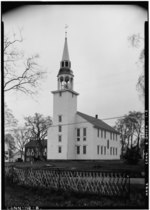Israel Putnam Monument

The Israel Putnam Monument is an equestrian statue located in Brooklyn, Connecticut, United States. The monument, designed by sculptor Karl Gerhardt, was dedicated in 1888 in honor of Israel Putnam, a Connecticut native who served as a general in the Continental Army during the American Revolutionary War. The monument was created as a response to the deteriorated condition of Putnam's grave in Brooklyn's cemetery, and the state government allocated funds for the monument with the provision that it also serve as a tomb for Putnam. Upon its completion, Putnam's remains were reinterred under the monument. The dedication was held on June 14 in a large ceremony with several guests of honor, including the governors of Connecticut and Rhode Island. The monument was criticized by contemporary reviewers, who especially criticized the horse, with one review noting that it appeared to be suffering from bone spavin.
Excerpt from the Wikipedia article Israel Putnam Monument (License: CC BY-SA 3.0, Authors, Images).Israel Putnam Monument
Canterbury Road,
Geographical coordinates (GPS) Address Nearby Places Show on map
Geographical coordinates (GPS)
| Latitude | Longitude |
|---|---|
| N 41.786388888889 ° | E -71.949722222222 ° |
Address
Canterbury Road 25
06234
Connecticut, United States
Open on Google Maps









